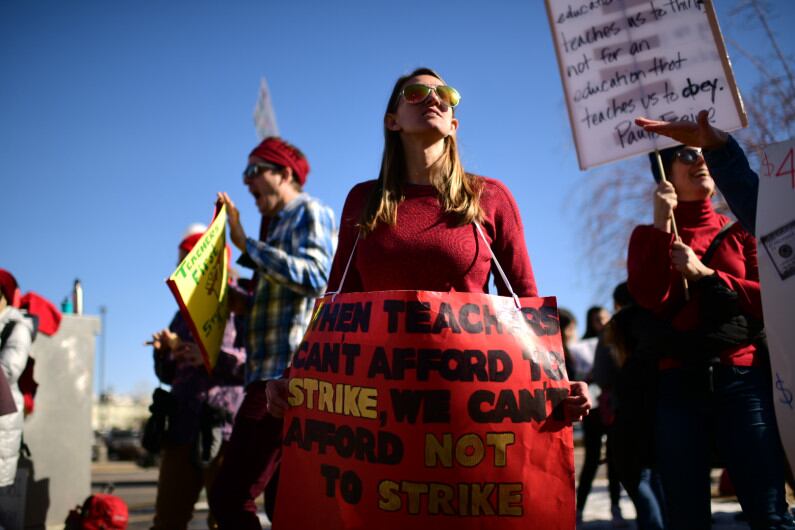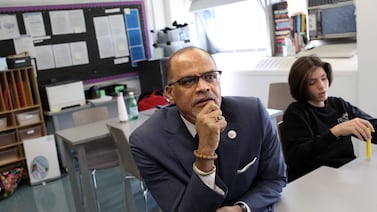Faced with a $65 million budget shortfall, the Denver school district plans to ask teachers to forgo some of the pay raises guaranteed by a hard-won union contract.
On Tuesday, Denver Public Schools sent a letter to the Denver Classroom Teachers Association requesting to reopen their three-year agreement, which the union and district signed after a three-day teacher strike last February.
“We are seeking to work collaboratively with the DCTA to find a solution that addresses the unprecedented revenue shortfall,” Superintendent Susana Cordova wrote in the letter.
Both sides must agree to any changes to the contract, which resulted in substantial raises for teachers this year. And there isn’t much time. By law, the Denver school board must approve a budget for the 2020-21 school year by June 30.
On Monday, district officials presented a proposal that showed eliminating teachers’ annual cost-of-living raises would save the district $7 million, while freezing step increases — or the pay raises teachers earn for notching another year of service — would save $9 million.
“We signed the contract with the intention of fully living up to it,” said Mark Ferrandino, the district’s deputy superintendent of operations, “and unfortunately, no one predicted a pandemic.”
Union President Tiffany Choi did not immediately respond to a request for comment Tuesday evening.
Colorado schools get money from a variety of sources, including state income and sales taxes, oil and gas revenue, and local property taxes. A coronavirus-induced economic downturn prompted state lawmakers to cut state education funding 5% per pupil next school year.
Denver Public Schools, the state’s largest district with 92,000 students, must cut its $1.1 billion budget as a result. The district plans to ask the public to weigh in on the cuts next week.
The proposal details ways to fill $40 million of the $65 million budget hole, and provides options for how to fill the rest. It aims to protect individual school budgets and the paychecks of low-wage workers, such as food service workers and custodians, while avoiding layoffs. Those goals align with priorities identified by a new budget advisory committee.
The biggest cuts would come from the district’s central office, which has long been criticized for being top-heavy and already underwent a round of cuts after the teacher strike last year. The proposal calls for making an additional $18 million in nonsalary cuts.
Those cuts would include canceling some third-party contracts, such as those related to the district’s school ratings, which another committee has suggested scrapping. It would also include adjusting school bell times so buses could run more efficiently, delaying the purchase of some curriculum, and transitioning from Microsoft software to a less costly Google platform.
Another $12 million in cuts would come from what district officials call “progressive pay adjustments.” Low-wage workers would get pay raises while higher-wage workers would see their salaries reduced through a combination of pay cuts and unpaid furlough days.
The proposal calls for the superintendent to take the biggest pay cut, at 10%. She currently makes $260,000 and has already pledged to take the cut.
Deputy superintendents would take a 5% pay cut, while other district administrators who make more than $100,000 would take cuts of anywhere from .75% to 2.5%.
School principals, who make an average of $64 an hour or $120,000 annually, would not see their pay cut. But they would forego cost-of-living raises.
District employees who make between $20 and $25 an hour would get a .5% pay increase in 2020-21. Those employees would include bus drivers and facilities managers.
Employees who make between $15 and $20 an hour, such as custodians and teachers’ aides, would get a 1% pay increase. And employees who make less than $15 an hour, such as food service workers, would get a 1.9% increase. Denver’s minimum wage will go up to $15.87 an hour in 2022, and officials said this proposal keeps the district on track to meet that.
Asking teachers, who make an average of $43 an hour or $65,000 annually, to forgo their guaranteed 1.9% cost-of-living pay increases would save $7 million, which is more than all of the other adjustments combined. If the union rejects that proposal, the salary savings would shrink from $12 million to $5 million, pushing the district to make cuts elsewhere.
In addition to the $30 million in cuts, the district proposes using $10 million in one-time federal relief funding to help plug the budget hole. The money comes from the Coronavirus Aid, Relief, and Economic Security Act passed by Congress.
Although the district expects to receive as much as $65 million total in CARES Act money, the federal funding cannot simply be used to help balance the district budget. For example, some of the money must be used by Dec. 31 and can only be spent on expenses directly related to COVID-19, such as cleaning classrooms or buying face masks.
The central office cuts, progressive pay adjustments, and CARES Act money add up to $40 million at most, which still leaves the district $25 million short. On Monday, officials presented the school board with a list of other options, all of which are more uncertain and less popular.
They include:
- Asking voters to increase taxes, which could net $10 million for school programs and $3.7 million for school construction needs. Although Denver voters have approved past tax increases, the poor economy makes it less certain they would do so this year.
- Freezing the step increases guaranteed in the teachers’ contract. This would save $9 million. The union would have to agree to this change, as well.
- Instituting steeper pay cuts for district employees, which could save up to another $6 million.
- Adding furlough days for employees on the higher end of the wage scale, which would save an additional $3.5 million per furlough day.
- Spending down some of the district’s $100 million budget reserve. While this will likely end up being part of the solution for next year, district officials dislike it because they say it’s a one-time fix that could put the district in a bad spot in future years.
The school board is set to hear public comment on the proposed budget on June 25. District officials hope that feedback will help shape a final budget proposal that includes ways to make up for the full $65 million shortfall. A vote is scheduled for June 29.








